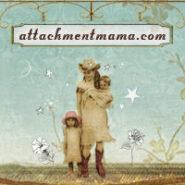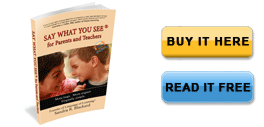Blogger Reviews SAY WHAT YOU SEE Handbook

I’m so honored! I just found out my SAY WHAT YOU SEE® for Parents and Teachers handbook got a great review on AttachmentMama.com:
Excellent Tools for Maintaining Consistent Respect for Our Children in Blackard’s “Say What You See”
“When we demonstrate love and respect, that’s what we get back” (pg 5).
THE BOOK IN A NUTSHELL
You know what’s so cool about this book? It IS a nutshell. It’s a little 50 page handbook that you can read in a half hour. I discovered the book at my daughter’s Montessori preschool. They were hosting a Language of Listening: Say What You See workshop for parents and had a stack of books available for purchase. I missed the workshop but was happy to purchase this quick read that had the school’s recommendation.
Sandra Blackard put together her “Say What You See” handbook and seminars based on communication concepts and techniques that she gleaned from play therapist, Dr. Garry L. Landreth, the author of Play Therapy: The Art of the Relationship.
She presents the concepts and techniques in a simple, easy-to-retain way that every sleep-deprived, toddler-challenged parent will appreciate.
The premise of the book is centered around the idea that loving, respectful relationships flourish when we see the good in our children regardless of their behavior — a great reminder and often difficult to put in practice. When we focus on the healthy need every behavior demonstrates rather than the behavior itself, we can build a new level of understanding and a deeper connection with our children.
“Say What You See” is broken down into six basic communication concepts that allow us to redirect our impulse to judge or express anger and instead see the good in our children in all circumstances.
1) “Responding to the Good in Children.” According to Blackard, when you say what you see, love and respect are automatic.
2) “Listening to Understand.” Everything children do and say is their way of communicating and they must continue to do so until they feel understood. You can listen to understand your child’s perspective by saying what you see and your understanding works like a fire extinguisher for their upset.
3) “Demonstrating Understanding.” You can do this by giving children your full attention at their eye level and matching the child’s mood with words, actions and facial expressions.
4) “Saying What You See.” Making observational statements about what you see as they relate to what the child is doing, saying, feeling and thinking.
5) “Adding Strengths.” To acknowledge your child, Blackard suggests refraining from generic “good job” praise which only leads a child to develop a dependency on parental approval and instead help build your child’s sense of self by adding statements about your child’s strengths after you say what you see.
6) When setting boundaries or rules, you can encourage self-control and creative problem solving by adding what your child can do after you say what you see.
QUESTIONS & ANSWERS:
1) What is the healthy need being expressed when my child tackles or hits me?
According to Blackard, the healthy need is physical connection. We can instead show them a secret handshake or a high five, or my common offer of a tickle fest. OR we can say what we see, acknowledge frustration and desire to hit something and offer up a pillow instead as something they can do.
2) What are some examples of “Saying What You See” as they relate to what a child is doing, saying, feeling, or thinking?
Doing: “I see you drawing orange circles” (focus on process vs. product) or “I heard a crashing sound” (versus “what are you doing in there?” which sets up defensiveness or lies.)
Saying: Repeat or rephrase what they say. “You are really, really, really, really hungry!” (direct quote from my daughter an hour after dinner).
Feeling: Validate all feelings. “You’re feeling really frustrated and sad because you really wanted to do that yourself.” (another direct quote from our house).
Thinking: Say what child appears to be thinking. “Looks like….” “Seems like….” , etc.
2) Where can I get a copy of this handbook?
You can buy the book and [online class] from the Language of Listening web site.
“SAY WHAT YOU SEE” PARENTING PRACTICES I’VE TRIED ON:
1) Modeling feelings to show understanding. My fondest memory of putting this into practice was when we took our toddler with us to a meeting with our attorney at his office. She was 22 months at the time and somehow we thought she could entertain herself in a small conference room while we talked about the light subject of our wills. HA! When she got upset because my husband opted to hold her for a while, I tried this method to see if it was the true “fire extinguisher.” I got super expressive both with my facial expression and voice to match her feelings and state what I thought she was frustrated about. And despite it working brilliantly, our attorney still made some crack about her having a crazy mom. I didn’t care.
2) Focusing on CAN-DO’s. I’ve been practicing the, “This is what you can do” forever, having picked it up elsewhere. For me, it’s effective 80% of the time in redirecting behavior.
3) Adding strengths. I have not put this into consistent practice having really just learned about its effectiveness in this handbook. I’ve been nervous about the detriments of praise since reading Kohn’s Unconditional Parenting and have focused on making statements about accomplishments or new skills learned instead of saying, “Good Job.” I’ll say things like, “You are getting dressed all by yourself! How does that feel?” or “I see you sharing with your sister. I can tell she likes that.” I really like what Blackard has to say about this in helping children recognize their own strengths and am excited to put this into practice.
Thank you Monica!





